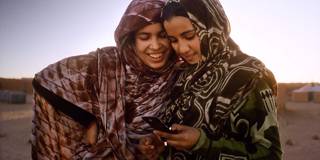The pandemic has exacerbated pre-existing inequalities, not least those disadvantaging women and girls in low- and middle-income countries. Fortunately, with today’s digital technologies, those providing health information and services for girls can reach them directly and privately like never before.
NAIROBI – When COVID-19 first appeared, some called it the “great equalizer,” because viruses do not discriminate according to socioeconomic factors. But we now know that the pandemic has reinforced and amplified pre-existing inequalities, particularly those that disadvantage women and girls. Lockdowns and other restrictions have placed girls at a heightened risk of violence, and have further deprived them of access to education, mobility, health care, and sexual and reproductive health services.
These problems will persist for years after the pandemic has ended. The Malala Fund estimates that some 20 million girls may never return to the classroom. Many will enter marriages at a younger age than they otherwise would have, with lifelong implications for their independence, opportunities, and earning potential. Moreover, the UN Population Fund finds that nearly 12 million women and girls in low- and middle-income countries have lost access to contraceptives over the past year, leading to 1.4 million additional unintended pregnancies.
Women and girls were at a disadvantage before the pandemic, but now they must fight harder than ever for their futures. Yet despite billions of dollars invested over the past decade in education, sexual health clinics, and other resources for girls, these services are consistently underused, even when they are free. Girls still face steep external barriers to access in the form of gender norms and misinformation, as well as low self-confidence, which stops many from taking action to improve their lives.

NAIROBI – When COVID-19 first appeared, some called it the “great equalizer,” because viruses do not discriminate according to socioeconomic factors. But we now know that the pandemic has reinforced and amplified pre-existing inequalities, particularly those that disadvantage women and girls. Lockdowns and other restrictions have placed girls at a heightened risk of violence, and have further deprived them of access to education, mobility, health care, and sexual and reproductive health services.
These problems will persist for years after the pandemic has ended. The Malala Fund estimates that some 20 million girls may never return to the classroom. Many will enter marriages at a younger age than they otherwise would have, with lifelong implications for their independence, opportunities, and earning potential. Moreover, the UN Population Fund finds that nearly 12 million women and girls in low- and middle-income countries have lost access to contraceptives over the past year, leading to 1.4 million additional unintended pregnancies.
Women and girls were at a disadvantage before the pandemic, but now they must fight harder than ever for their futures. Yet despite billions of dollars invested over the past decade in education, sexual health clinics, and other resources for girls, these services are consistently underused, even when they are free. Girls still face steep external barriers to access in the form of gender norms and misinformation, as well as low self-confidence, which stops many from taking action to improve their lives.